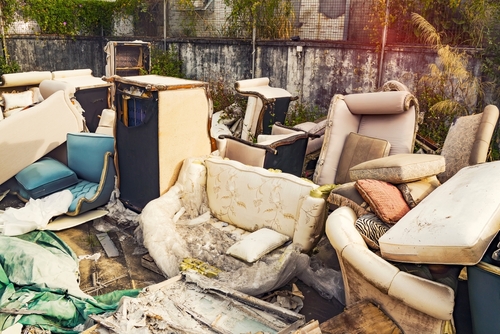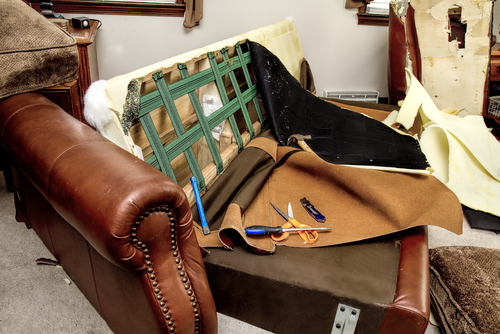May 9, 2024 - Benjamin Ehinger
How to Break Down a Couch for Trash: A Step-by-Step Guide
CALL NOW 844-762-8449
Breaking down a couch for disposal might seem daunting, but with the correct guidance, it’s a task you can tackle. Disposing of an old couch involves more than tossing it out with the garbage; it requires a systematic approach to take it apart and dispose of it responsibly. Whether you’re making room for a new sofa or simply clearing out space, learning to properly break down and dispose of your couch is crucial. It’s not only helpful for managing your household waste but also important for the environment.
Efficiently dismantling a couch for trash is a handy skill that allows you to be environmentally conscious while handling large furniture disposal. Before embarking on the task, ensure you have the necessary tools and have reviewed local disposal regulations. While some couch components can be recycled, others may be suitable for donation, offering a sustainable way to extend the life of your furniture. After breaking down your couch, carefully separate the parts for recycling, donation, or waste, and clean the area to prevent leaving any remnants.
 When considering how to dispose of your unwanted couch, you have several options that can be environmentally friendly. These include selling or donating the couch for reuse or exploring recycling and upcycling avenues.
When considering how to dispose of your unwanted couch, you have several options that can be environmentally friendly. These include selling or donating the couch for reuse or exploring recycling and upcycling avenues.
Key Takeaways
- Proper dismantling of a couch eases the disposal and recycling process.
- Knowing local disposal regulations and donation options can enhance sustainability.
- Following the breakdown, separate components accordingly and clean the area.
Preparing to Dismantle Your Couch
Before you start, it’s crucial to gather the right tools and understand the type of sofa you’re working with. This ensures an efficient and safe dismantling process.Gathering Necessary Tools
For a successful dismantling, you’ll need specific tools at your disposal:- A screwdriver for removing screws.
- An Allen wrench for hexagonal or square fasteners.
- A box cutter or scissors for cutting away fabric.
- A hammer for any nails or tacks.
- A staple puller for removing staples that secure the upholstery.
- A handsaw may be necessary for sawing through wooden frame parts.
Assessing Your Couch Type
Your approach will vary depending on the type of sofa:- Standard sofa: Inspect for visible screws and fasteners. Look underneath and remove any dust covers to reveal the framework.
- Sofa bed: Exercise caution due to the mechanical components. You’ll likely need to remove the mattress before getting to the hinges and frame.
Breaking Down the Couch
When you’re preparing to throw away an old couch, the key steps involve removing all cushions and upholstery before tackling the frame and legs.Removing Cushions and Upholstery
- Remove the upholstery: Inspect your sofa for any screws or fasteners that may be holding the fabric in place. Use a flathead screwdriver or staple puller to gently pull out staples or screws. Carefully cut away the fabric if it’s sewn on, making sure not to damage the underlying frame.
- Cushions and pillows: If your cushions are not sewn into the couch, simply lift and set them aside. For attached cushions, you may need to use a box cutter or seam ripper to remove attached sofa cushions without ripping the fabric.
Disassembling Frame and Legs
- Legs: Start by flipping the couch to access the legs. Using an Allen wrench or Phillips head screwdriver, unscrew and remove each leg. Keep these screws in a safe place in case you need them later.
- Metal frame: Locate any bolts or screws securing the metal frame and use the appropriate screwdriver to detach them. If you need to detach an arm from your sofa, look for screws or bolts inside the frame or underneath the upholstery that you just removed.
Disposal and Environmental Considerations
 When considering how to dispose of your unwanted couch, you have several options that can be environmentally friendly. These include selling or donating the couch for reuse or exploring recycling and upcycling avenues.
When considering how to dispose of your unwanted couch, you have several options that can be environmentally friendly. These include selling or donating the couch for reuse or exploring recycling and upcycling avenues.
Selling or Donating Your Couch
To minimize waste and keep your couch out of a landfill, consider selling or donating it. Platforms such as Craigslist and Facebook Marketplace are popular for selling to local buyers. Freecycle.org can also be used for giving away items to your community members who can use them. If you prefer to donate, charities such as Goodwill or The Salvation Army often accept furniture that is in good condition and may offer pick-up services. This not only extends the life of your couch but also aids people in need.- Sell on:
- Craigslist
- Facebook Marketplace
- Donate to:
- Goodwill
- Salvation Army
- Local charities
Recycling and Upcycling Options
Recycling or upcycling your couch can be another sustainable choice. Before sending it off to a junk removal service, consider if any parts can be recycled or repurposed. Upcycling parts of your couch into new items can be a creative way to reduce waste. Check with local recycling centers as some may have specific programs for furniture. Remember that choosing to recycle when possible helps reduce the burden on landfills and conserves resources.- Check for recycling with:
- Local recycling centers
- Consider upcycling:
- DIY projects using couch materials
Final Cleanup
After successfully disassembling your couch and sorting out the materials, your final task is to manage the remaining debris and restore the area to its original condition. This ensures a safe and clean environment, and allows for proper waste management.Handling Remaining Debris
Once all major components of your couch have been dismantled, you’ll likely be left with some debris. Whether it’s loose fabric, small wood pieces, or metal parts, it’s important to gather and dispose of these bits properly. If you’ve rented a dumpster, ensure that all debris is placed inside. For items not suitable for a local dumpster, such as hazardous material, you should find the appropriate waste management facility to handle them. Here’s how to proceed:- Collect small debris:
- Use a broom or a vacuum to sweep up any dust and small particles.
- If there are splinters or sharp objects, put on gloves and pick them up carefully.
- Dispose of the debris:
- Place all non-hazardous debris in trash bags.
- Check with your local waste management guidelines for disposing of items that should not go into the dumpster rental.
Restoring the Area
After you’ve gotten rid of all the debris, it’s time to return the space back to its original state. This includes cleaning up the area where the couch was, moving furniture back into place if necessary, and ensuring there’s no damage to your home. Follow these simple steps:- Clean the space:
- Sweep and mop the floor, or vacuum if it’s carpeted.
- Wipe down any surrounding furniture or surfaces that may have collected dust.
- Inspect and arrange:
- Look over the space for any damage that might have occurred during the disassembly.
- Rearrange any displaced items, ensuring the room is tidy and hazard-free.
Frequently Asked Questions
Before you start the disassembly of your sofa, it’s important to prepare the necessary tools and understand the process involved. Each step may vary depending on the style and design of your couch.What tools are needed to dismantle a sofa?
You will typically need a screwdriver, a hammer, pliers, and a saw or utility knife. These tools will help you remove the sofa’s legs, arms, and potentially cut through tough materials.What are the steps for removing the arms from a sofa?
Start by locating the staples or screws that attach the arms to the frame. You may need to remove fabric or upholstery to access them. Once exposed, unscrew or pry the staples out carefully, and gently detach the arms from the frame.Can a reclining couch be taken apart, and if so, how?
Yes, a reclining couch can be disassembled. Begin by detaching the back of the couch from the seat, often held by locking levers. Then, remove the screws or bolts that secure the reclining mechanism and arms.What is the best method to disassemble a large couch?
For a large couch, start by removing the cushions and any slipcovers. Unscrew the legs and flip the couch over to take off the upholstery underneath. You may need to saw through the frame in sections for easier disposal.How should one dispose of an old sofa after disassembly?
After breaking down your sofa, schedule a trash pickup or bring it to a local waste disposal site. Some areas have bulk waste collection days specifically for items like furniture.Are there services available for sofa disassembly and reassembly?
If you’re not up for a DIY project, there are professionals who offer furniture removal services. These experts can disassemble, remove, and, if needed, reassemble your sofa in a new location.RECENT BLOGS
Our Reviews
Glenda Lanier Prowell
1721758635
I have ordered an 11 yard dumpster to be delivered to my house.Lonier was extremely helpful and answered all my questions. The rate was very reasonable.
Cedric Smikle
1721660395
Amber was extremely professional and courteous. She answered all of my questions and even some that I didn’t know I needed to ask.
Cait Kaider
1721243051
I highly recommend Waste Removal USA for their responsiveness and how the staff work hard to provide exceptional customer service. They have done well by us and our clients. Thank you!
Easom Family
1721223306
Louiner Pierre-Louis Is awesome! Did a great job. Will definitely be using this same company for all my dumpster needs because of his awesome customer service! Thank you!!!
tabitha Vazquez
1720539988
Wonderful and fast customer service!
LATEST BLOGS






